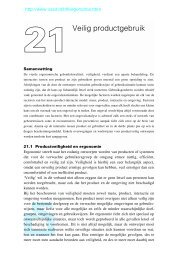Pre-industrial dredging Rosmolens en krabbelaars: baggeren ... - Vssd
Pre-industrial dredging Rosmolens en krabbelaars: baggeren ... - Vssd
Pre-industrial dredging Rosmolens en krabbelaars: baggeren ... - Vssd
You also want an ePaper? Increase the reach of your titles
YUMPU automatically turns print PDFs into web optimized ePapers that Google loves.
22 Het grote baggermol<strong>en</strong>boek<br />
3 Baggerbeugel.<br />
Dredge bag or hand drag, a leather or wov<strong>en</strong> bag on a long pole<br />
4 Beugelaar<br />
The Dredger; the man who worked with the dredge bag<br />
The Netherlands’ main port in the early Middle<br />
Ages was Dorestad, some 100 miles up the river<br />
Rhine (now Lek) from the sea. While shipbuilding<br />
techniques evolved and ships’ sizes increased,<br />
from, say, the 50 tons flatbottomed clinker built<br />
cog to the 150 tons keel ships of the 16th c<strong>en</strong>tury,<br />
mariners choose deeper ports closer to the sea,<br />
which in the 17th c<strong>en</strong>tury made Amsterdam the<br />
Dutch main port, with Rotterdam and Dordrecht<br />
as runners up. Moving further to seaward was<br />
unpractical, but silting became an ever bigger<br />
problem while ships’ sizes continued to increase.<br />
Logical therefore that the 16th c<strong>en</strong>tury saw the<br />
introduction of more sophisticated <strong>dredging</strong><br />
equipm<strong>en</strong>t than the hitherto predominant dredge<br />
bag (fig. 3 and 4) (Dutch ‘baggerbeugel’: a leather<br />
bag on a long pole), which ev<strong>en</strong> in the 20th c<strong>en</strong>tury<br />
was still widely used, for instance for relieve work<br />
during the 1930s Great Depression, wh<strong>en</strong> many<br />
unemployed people worked for their dole through<br />
maint<strong>en</strong>ance work of canals.<br />
A number of improved dredge bags were<br />
pat<strong>en</strong>ted, such as the haalschouw by famous
















